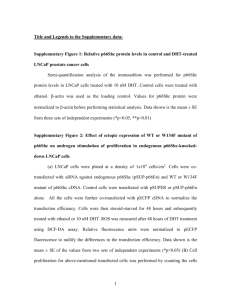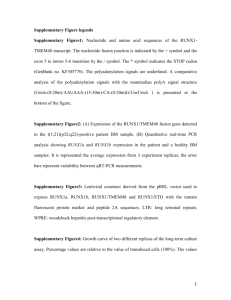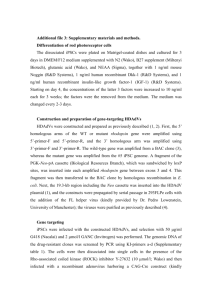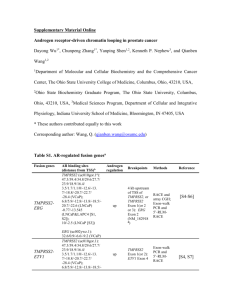Supplemental Data Legends (docx 25K)
advertisement
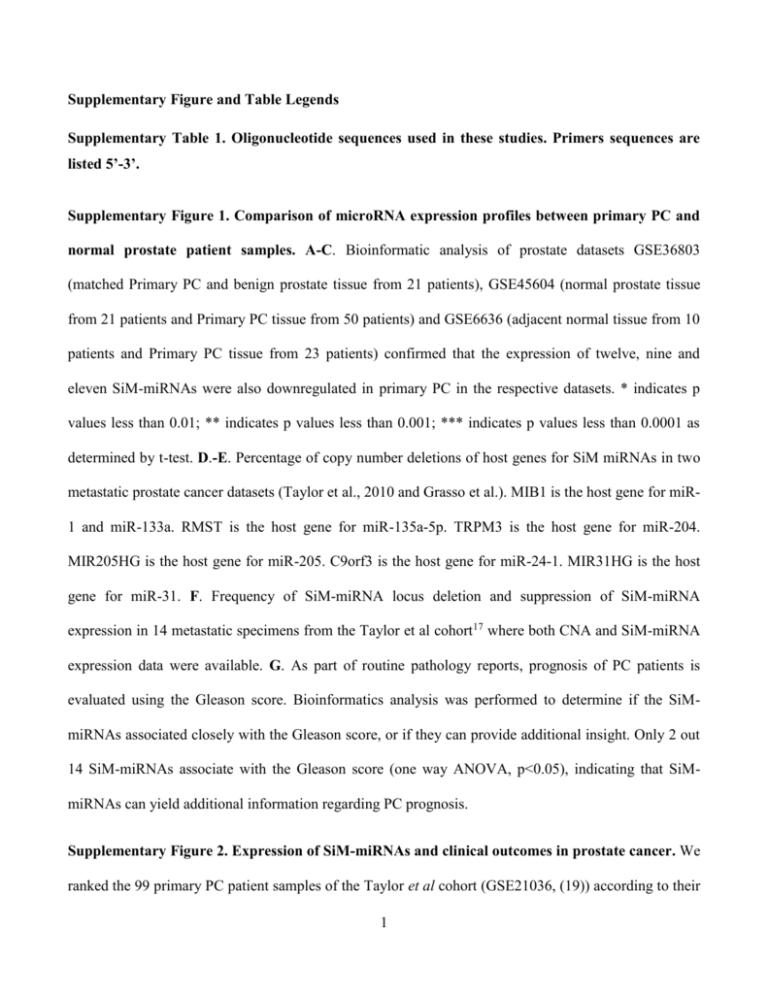
Supplementary Figure and Table Legends Supplementary Table 1. Oligonucleotide sequences used in these studies. Primers sequences are listed 5’-3’. Supplementary Figure 1. Comparison of microRNA expression profiles between primary PC and normal prostate patient samples. A-C. Bioinformatic analysis of prostate datasets GSE36803 (matched Primary PC and benign prostate tissue from 21 patients), GSE45604 (normal prostate tissue from 21 patients and Primary PC tissue from 50 patients) and GSE6636 (adjacent normal tissue from 10 patients and Primary PC tissue from 23 patients) confirmed that the expression of twelve, nine and eleven SiM-miRNAs were also downregulated in primary PC in the respective datasets. * indicates p values less than 0.01; ** indicates p values less than 0.001; *** indicates p values less than 0.0001 as determined by t-test. D.-E. Percentage of copy number deletions of host genes for SiM miRNAs in two metastatic prostate cancer datasets (Taylor et al., 2010 and Grasso et al.). MIB1 is the host gene for miR1 and miR-133a. RMST is the host gene for miR-135a-5p. TRPM3 is the host gene for miR-204. MIR205HG is the host gene for miR-205. C9orf3 is the host gene for miR-24-1. MIR31HG is the host gene for miR-31. F. Frequency of SiM-miRNA locus deletion and suppression of SiM-miRNA expression in 14 metastatic specimens from the Taylor et al cohort17 where both CNA and SiM-miRNA expression data were available. G. As part of routine pathology reports, prognosis of PC patients is evaluated using the Gleason score. Bioinformatics analysis was performed to determine if the SiMmiRNAs associated closely with the Gleason score, or if they can provide additional insight. Only 2 out 14 SiM-miRNAs associate with the Gleason score (one way ANOVA, p<0.05), indicating that SiMmiRNAs can yield additional information regarding PC prognosis. Supplementary Figure 2. Expression of SiM-miRNAs and clinical outcomes in prostate cancer. We ranked the 99 primary PC patient samples of the Taylor et al cohort (GSE21036, (19)) according to their 1 individual miRNA z-score (compared to normal prostate tissue) for each SiM-miRNA. We then compared the biochemical recurrence (BCR)-free survival between the bottom quartile and the top 3 quartiles of the ranked specimens using the log-rank test. As shown, there was no statistically significant association between expression of miR-143-5p, miR-204, miR143-3p, miR-24-1-5p and BCR-free survival (p> 0.05). Supplementary Figure 3. Restoration of expression of SiM-miRNAs alters multiple cell cycle pathways in PC cells. LNCaP cells were transfected with SiM-miRNA mimetics for 48 hours, followed by RPPA. Pathway analysis was run on the identified target protein changes utilizing the CPDB database with a minimum threshold of 4 recurrent SiM-miRNAs per pathway (p<0.05). The most frequently altered pathway is G1/S transition. Supplementary Figure 4. Proteomic analysis of PC cells following restoration of expression of SiM microRNAs. A. Enlarged, higher resolution version of Main Fig. 4A (diagrammatic and pie chart representation of cell cycle G1/S transition and mTOR signaling proteins and pathways altered by expression of the 12 prostate cancer-relevant miR mimetics in LNCaP cells). It is provided in this Supplement to allow the reader to review it in higher resolution. B-M. Heat maps of the proteins significantly altered (as assessed by RPPA) by expression of the 12 prostate cancer-relevant microRNA mimetics in LNCaP cells. Please note that Supplementary Figure 4 B is an enlarged, higher resolution version of Main Fig. 4D. It is provided in this Supplement to allow the reader to review it in higher resolution. Supplementary Table 2. Evaluation of direct SiM-miRNA effects on the proteomic changes assayed via RPPA. We evaluated the potential for direct miRNA effects on the proteins measured via 2 RPPA by using a union of five leading prediction algorithms: TargetScan, miRanda, PicTar, DianaLab, and miRDB. A protein change could be explained by direct SiM-miRNA effects if it was downregulated and predicted to the targeted of a SiM-miRNA by at least one out of the five algorithms. Out of 466 observed significant protein changes (both up- and down-regulated), only 56 (12.01%) could be explained as direct effects of the SiM-miRNAs, suggesting that the vast majority (87.99%) were the results of indirect effects. Supplementary Table 3. Proteomic signature for 12 Sim-MiRNAs transfected into LNCaP cells. Combined proteomic signatures for 12 Sim-MiRNAs transfected into LNCaP cells for 48 hours. Columns correspond to Sim-MiRNA transfection experiments, and rows correspond to RPPA antibodies; both antibody full names and the protein names are shown. For each pair of SiM-MiRNA and the significantly changed antibody, we show in the corresponding cell the fold change (log2transformed) if q<0.05 , otherwise an empty cell is used. Supplementary Table 4. Prediction of SiM-miRNAs on steroid receptor coactivators. Using a union of five leading prediction algorithms: TargetScan, miRanda, PicTar, DianaLab, and miRDB, we queried whether the SiM miRNAs could target SRC1, SRC2 and SRC3. Table shows that SRC1 is predicted by 3 algorithms to be targeted by miR-135a-5p. Supplementary Table 5. Evidence of SiM-miRNA/mRNA interaction in AGO HITS-CLIP and AGO PAR-CLIP datasets. Publicly available Argonaute (AGO) HITS-CLIP and PAR-CLIP datasets were interrogated using the Starbase compendium (http://starbase.sysu.edu.cn). Enriched regions were intersected with the genes of interest: AR, SRC1 (NCOA1), SRC2 (NCOA2), SRC3 (NCOA3), and ROCK1 using BEDTools. MicroRNA seeds were matched to the peak regions using miRanda. Typically miRNA-mRNA prediction algorithms focus on 3’UTR to reduce the false positives. However, 5’UTR 3 and coding regions miRNA/mRNA bindings have been published and experimentally validated with Argonaute HITS-CLIP and PAR-CLIP sequencing. Table shows that AR can be targeted by miR-133a in BT474 cells; BT474 expresses AR at low levels; AR protein was significantly suppressed by treatment of LNCaP cells with miR-133a-5p. Perhaps due to the role of p160 steroid receptor coactivators SRC1, SRC2, and SRC3 as pleiotropic transcription regulators, SiM-miRNAs are predicted to target them via HITS-CLIP or PAR-CLIP in multiple samples. Specifically, we found on SRC1 targets of miR-135a-5p, miR-1-5p, miR-221-5p, and miR-24-1-5p in BCBL-1 and DG75 cells, and by miR-143-5p in HEK293 cells, BC-1 cells, Epstein-Barr virus B95.8-infected lymphoblastoid cell lines; interestingly, miR-135a-5p, miR-1-5p, and miR-143-5p were predicted to target SRC1 3’UTR via multiple miRNA/mRNA prediction algorithms as well. On SRC2, we found targets of miR-205, miR31, miR-221-5p, and miR-221-3 in BCBL-1 and DG75 cells, of miR-143-5p and miR-204 in HeLa cells, of miR-1-5p in human embryonic stem cells WA09, and of miR-143-5p in MCF7 cells. miRNA/mRNA prediction algorithms suggested only miR-1 has binding to SRC2. Overlapping these data with SRC3, we observed that SRC3 was a target of miR-133a-5p in BCBL-1 and DG75 cells and in BT474 cells; of miR-205 in HeLa cells, and of miR-31 in MCF7 cells. MiR-205 was only predicted to target SRC3 using the miRNA/mRNA prediction algorithms. As a positive control for the AGO CLIP analysis, we found evidence for miR-135a-5p binding to the ROCK1 gene in HeLa cells, confirming the regulation reported by Kroiss et al., 2014. Alignment score, Energy (kCal/Mol), Alignment length, Alignment % (miRNA seed) and Alignment % (CLIP peak) were obtained using the miRanda algorithm. References for GEO studies are also listed in Supplementary Table 5. Supplementary Figure 5. Re-expression of miR-135a-5p depletes SRC1 but not AR, SRC2, or SRC3 in prostate cancer cells. LNCaP (A) and LAPC4 (B) cells were transfected with miR-NT or miR-135a-5p mimic for 48 hours. Following this, total RNA was isolated and reverse transcribed. 4 Quantitative PCR was performed for the expression levels of AR, SRC1, SRC2, and SRC3. The relative expression of each mRNA was normalized to the expression levels of β-Actin mRNA in the cells. Bars, s.e. Supplementary Figure 6. Correlation between SiM-miRNA expression and AR transcriptional activity in PC tissues. A. We utilized mRNA and miRNA expression data from the primary PC samples of the Taylor et al cohort dataset (GSE21036) and applied a transcriptomic signature derived from LNCaP cells treated with 2 different AR siRNAs. We computed gene signature activity for each specimen, then computed the Pearson correlation coefficient (PCC, p<0.05) with each of the 12 SiMmiRNAs. We observed that for 11 out of the 12 SiM-miRNAs, the miRNA levels are positively correlated with the presence of a gene signature generated by silencing AR (i.e. inversely correlated with AR transcriptional activity), further supporting the role of SiM-miRNAs in the regulation of the AR axis in PC. The only exception was miR-135a (NS: non-significant). B-C. Scatterplots for siAR-A and siARB gene signature compared to the miRNA expression levels in Taylor et al cohort dataset. MicroRNA expression levels positively correlate with the presence of a gene signature generated by silencing AR with 2 different siRNAs (i.e. inversely correlated with AR transcriptional activity). D. Utilizing publicly available data and GSEA, we integrated a transcriptome footprint from LNCaP cells after re-expressing the miR-135a microRNAs contributed by Kroiss et al ( GSE45620), and determined that AR-induced genes (down-regulated by AR) are significantly enriched (NES ranging from -2.54 to -1.94, q <0.02). Supplementary Figure 7. Re-expression of miR-135a-5p suppresses genes related to metastasis in PC cells. Gene Set Enrichment Analysis (GSEA) of the miR-135a transcriptome profile in LNCaP PC cells demonstrated that genes upregulated in metastatic PC are suppressed by re-expression of miR135a-5p in LNCaP cells (NES -1.88, q<0.09). 5 Supplementary Figure 8. Androgen induces miR-135a-5p expression in PC cells. A. LAPC4 cells were plated in media supplemented with 10% charcoal stripped FBS for 48 hours. Then, R1881 (1 nM) was added and the cells were incubated for an additional 24 hours. At the end of treatment, total RNA was isolated by the Trizol method and reverse transcribed. Stem loop-mediated reverse transcription of mRNA was performed with 250 ng of total RNA for miR-135a-5p and RNU6B. Relative expression of miR-135a-5p in each cell line was determined by quantitative PCR and normalized to RNU6B. Bars, s.e. Supplementary Table 6. Comparison of H3K4Me3 and H3K27Me3 signal at the miR-135a-5p, miR-221-5p, miR-1, and miR-31 loci. To establish the background distribution, we determined the number of reads within a genomic window both 50-kb upstream and downstream; this approach is similar to the one used by the MACS2 algorithm for ChIP-Seq peak calling. For each locus and SiMmiRNA we calculated the ratio [reads at regulation site, defined by enrichment of either H3k4Me3 or h3k27Me3]/[reads within 50 kbp of the locus in both directions]. Significance of difference in binding between PrEC and LNCaP was established using Fisher's exact test (p<0.05). Locations of sites for epigenomic comparisons are given with respect to UCSC hg19/NCBI 37 human genome builds. Supplementary Figure 9. Epigenetic features and chromatin structure determines expression and accessibility of miR-1, miR-31 and miR-221-5p in aggressive PC versus normal prostate epithelial cells. We examined ChIP-Seq datasets for H3K4Me3 and H3K27Me3 from PrEC and LNCaP cells. Chromatin mark profiles were visualized utilizing the IGV browser. For each cell line and each ChIP track, the intensity of the peak height is noted in the left hand corner of each IGV track. The direction of the host gene expression and the microRNA expression are noted with black arrows. A. Chromatin mark profiles for H3K4Me3 and H3K27Me3 at the miR221/miR-222 cluster in PrEC and LNCaP cells. B. The MIB1 gene, the host gene for miR-133a and miR-1, shows strong signal for the permissive H3K4Me3 chromatin mark in PrEC, whereas this chromatin mark is much less prevalent at MIB1 in 6 LNCaP cells. C. IGV tracks of H3K4Me3 and H3K27Me3 in PrEC and LNCaP cells. The region upstream of the miR-31 host gene also exhibits significant signal for the permissive H3K4Me3 chromatin mark in PrEC cells while this chromatin mark is nearly absent in the LNCaP cells. The miR31 host gene exhibits stronger signal for the repressive chromatin mark H3K27Me3 in LNCaP than in PrEC cells. The direction of expression of the host gene and corresponding miRNA is indicated with block arrows. Supplementary Figure 10. Treatment with pan-histone deacetylase inhibitor, DNA methyltransferase (DNMT1) inhibitor and EZH2 siRNA reactivates miR-135a-5p expression in PC cells. A-B. VCaP cells were treated as indicated for 24 hours with vorinostat (VS, A) or 96 hours with the DNMT1 inhibitor, 5-azacitidine (5-Aza, B). Total RNA was isolated and reverse transcribed utilizing a stem loop-mediated reverse transcription kit for miR-135a-5p, miR-1, and miR-221-5p. Relative expression of each miR was determined by quantitative PCR and normalized to RNU6B. Bars, s.e. C. LAPC4 cells were transfected with si-NT or two different EZH2 siRNAs for 48 hours. At the end of treatment, total RNA was isolated by the Trizol method. Stem loop-mediated reverse transcription of miR-135a-5p was performed with 250 ng of total RNA. Relative expression of miR-135a-5p was determined by quantitative PCR and normalized to RNU6B. Bars, s.e. 7
